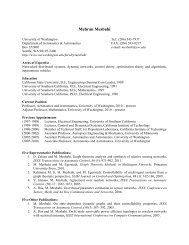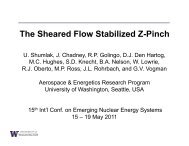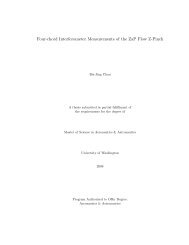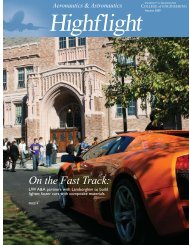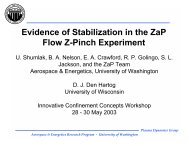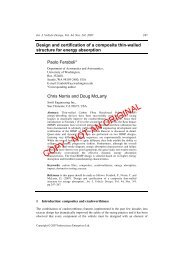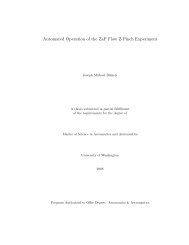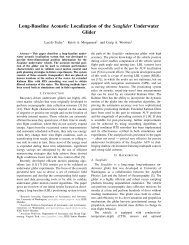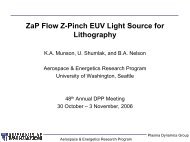Distributed Reactive Collision Avoidance - University of Washington
Distributed Reactive Collision Avoidance - University of Washington
Distributed Reactive Collision Avoidance - University of Washington
Create successful ePaper yourself
Turn your PDF publications into a flip-book with our unique Google optimized e-Paper software.
4<br />
ahead or time horizon so that the solution does not have to be recalculated <strong>of</strong>ten. Force field<br />
approaches use continuous feedback mechanisms to compute the control. Commonly, the<br />
force field between two vehicles is akin to the repulsion between two like-charged particles,<br />
however there are many possible alternatives for feedback schemes. These approaches are<br />
generally reactive, in that the control reacts to the current state <strong>of</strong> the system, rather than<br />
planning a trajectory ahead <strong>of</strong> time.<br />
The next differentiator between collision avoidance algorithms is their degree <strong>of</strong> centralization.<br />
Centralized means that all <strong>of</strong> the information about the vehicles is sent to a<br />
single server where the controls are calculated for each vehicle and sent back. The current<br />
air traffic control system uses centralization (with human operators), as do most optimization<br />
schemes. The other extreme is decentralization, in which no central server exists and<br />
each vehicle computes its own control based only on other vehicles within a particular range<br />
<strong>of</strong> itself. This situation is ideal from a computational perspective because there is a limit to<br />
how many vehicles can be within range at once, and therefore there is a limit to how much<br />
time the algorithm will take to run, regardless <strong>of</strong> the total number <strong>of</strong> vehicles involved. In<br />
between is a category termed distributed, in which there is still no central server and each<br />
vehicle computes its own control but may need more than local information to do so. In this<br />
case, computations scale with the number <strong>of</strong> vehicles involved (n), but the scaling is at least<br />
O(n) better than the centralized case, because now n separate processors are computing in<br />
parallel, rather than one server doing all the work.<br />
The vehicle model used in each formulation is also <strong>of</strong> utmost importance to the algorithm’s<br />
applicability to real systems. First, for collision avoidance to be nontrivial, the<br />
dynamics must be at least second order (acceleration-level control input), and the control<br />
inputs must be bounded to model the difficulties <strong>of</strong> overcoming inertia. Many vehicles<br />
(cars, ships, airplanes, etc.) have nonholonomic constraints, and as such are <strong>of</strong>ten modeled<br />
at a high level by unicycle dynamics. The inputs to this model are forward acceleration<br />
and heading rate (which is equivalent to acceleration normal to the velocity). All vehicles<br />
have a maximum speed, but some vehicles (notably airplanes) also have a positive min-



